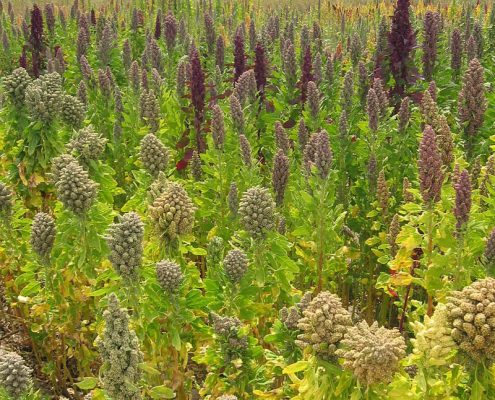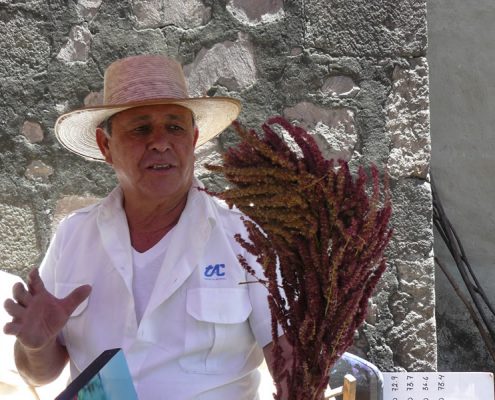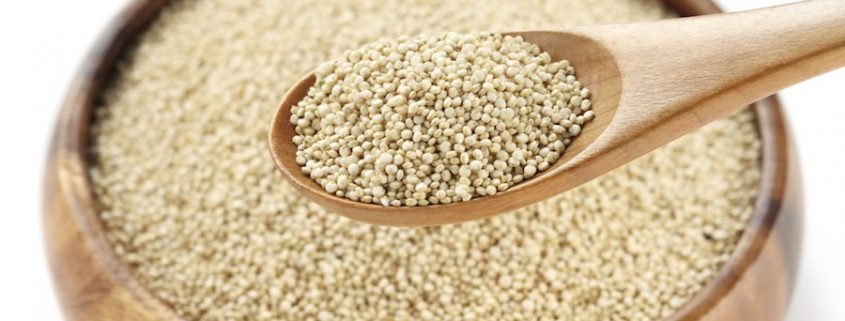Peru: Quinoa conquering more markets
By César Marcos.
It is the ancestral food that gives the Pachamama (Mother Earth) and the Andean wisdom has cultivated for 7000 years. But the world could not take advantage of that time, even the Spaniards who settled along the Andes, the backbone of Latin America, the high content of vitamins, minerals and fiber mother of all seeds. Quinoa atavistic takes part of the diet of astronauts in space.
This pseudocereal is so key “for the opportunity that is within the region of Latin America to be able to reverse the growing food deficits in other countries,” said Secretary of Rural Development of Argentina, Carla Campos Bilbao, during the celebration of V World Congress of Quinoa and II Symposium on Andean grains, Jujuy (Argentina).
http://congresoquinua.com.ar/
“There are opportunities passing and should be exploited,” stressed the Minister of Production of the Province of Jujuy, Gabriel Romarovsky and Plant Protection Officer of the Regional Office of FAO, Tania Santiváñez, stated in Congress that “it is important that quinoa is present in the table of all people, of all races and cultures, but obviously first have to work for this to happen in our region.”
Argentine authorities expressed their commitment to encourage the quinoa. Indeed, the V World Congress of Quinoa has been organized in this country to compile experience and agronomic expertise to develop their culture and their inclusion in regional economies. For now, “we have pointed to the production of quinoa, which at the time did very little and today we are reaching 14,000 kg / year,” City Commissioner Cusi Cusi, Guillermo Arias.
Dethrones Peru Bolivia
Until the mid-90s, Peru exported 6% of the world quinoa and Ecuador 2%. Bolivia dominated the trade with 90% of exports. Twenty years later, the progressive intensification of the culture below highland pared positions. Peruvian foreign sales quota rose to 23% in 2012, according to FAO sources.
However in 2014, Peru has driven Bolivia: It produced 95,000 tonnes and 25,230 tonnes exported, while Bolivian producers were able to harvest 84,000 tons and export 23 461 exported. Still, Bolivia has obtained greater benefit, for the best prices of organic quinoa (ecological) versus conventional quotes.
http://gestion.pe/economia/exportaciones-peruanas-granos-andinos-crecieron-167-mayor-eeuu-y-canada-2110755
A versatile crop
Takes root in the highest, in semi-arid plains, but adapts to the valleys, both dry and wet. Quinoa grows even at sea level. In the Sierra of Peru, the organic quinoa is grown. Puno is the first producing region of the country. But the conventional management of the plant (not organic) extends to the coast.
 Proquinua is a program of the Ministry of Agriculture of Peru that seeks areas of the coast where you can get better yields. One is Lambayeque, where rice cultivation will replace the quinoa to adjust production to foreign markets that demand conventional quinoa.
Proquinua is a program of the Ministry of Agriculture of Peru that seeks areas of the coast where you can get better yields. One is Lambayeque, where rice cultivation will replace the quinoa to adjust production to foreign markets that demand conventional quinoa.
http://www.inia.gob.pe/sala-de-prensa/notas-de-prensa/753-inia-apoya-programa-proquinua-para-reconversion-agraria
“In Puno the average is 1.2 tons / ha and Arequipa 5 tonnes / ha is achieved,” says agricultural engineer Carlos Neuenschwander to Redagrícola. On the coast, two crops are obtained annually and farmers use modern irrigation, fertilization frequent localized, in addition to the crop will benefit a milder climate.
However, the most threatening plague is quinoa mildew fungus, affecting farms of Puno and even on the coast. Only a low relative humidity (20%) and dry weather hampering their attack, as in irrigated plantations of La Joya and Majes have less. As prevention, we must disinfect the seed before planting.
The growth rate of the conventional production of quinoa, organic farming prices continue to fall, as regrets the Association of Organic Producers of Quinoa in Ayacucho. In Peru, the volume of the organic quinoa is lower than conventional, now sells smuggled into Bolivia to mix with organic and export, but that the popularity of the golden seed is placed at risk.
A reputation to uphold
In the international markets increasingly importers expect. The United States also has to produce quinoa and food authorities are refusing episodically pseudocereal revenues of Peru alleging the presence of pesticide residues that exceed the maximum permissible limits on arrival. The Chamber of Commerce of Lima cautions and inspections may be intensifying.
 Peruvian producers are aware that some erroneous practices of farmers, mixing the organic quinoa with conventional saw the coast, so the aim is that from Arequipa, in the valley to the coast, are grown more hectares of organic quinoa to meet without difficulty the requirements of the Food and Drug Administration (FDA, for its acronym in English).
Peruvian producers are aware that some erroneous practices of farmers, mixing the organic quinoa with conventional saw the coast, so the aim is that from Arequipa, in the valley to the coast, are grown more hectares of organic quinoa to meet without difficulty the requirements of the Food and Drug Administration (FDA, for its acronym in English).
http://www.camaralima.org.pe/principal
Mixtures of varieties of quinoa and grain impurities are valued less by importers, who prefer the color quinoa grain is white and uniform and that the size is large and even.
Quinoa in Europe
Italy and France and grown quinoa, as the French region of Anjou. Spain will just add to his growing modestly in 2014, which has increased in 2015. The company has planted Algosur quinoa in the Lower Guadalquivir, the Vega of Seville and the province of Cadiz (Andalusia). Antonio Martin, President of Algosur, with other farmers, sown quinoa in February and March, some 1,300 hectares (ha),. The cultivation is carried out under integrated production practices, except for a portion to be certified as organic.
[https://plus.google.com/107107493580650648864/about?gl=es&hl=es]
The company has invested 3.5 million euros in a factory that will process initially between 6,000 and 7,000 tons of quinoa, but capable of reaching the 25,000 tons of grain. 75% of its production is exported to US, Canada, Japan and Europe.
“You do not need fertilizers or too much water, and withstand extreme temperatures and frost as those produced in Castile and Leon”, he stressed to EFE, the engineer Dr. agronomist Cristina Lucini, who leads the research group of Plant Production and Food Quality Catholic University of Avila (UCAV). They have already been planted in small plots with tricolor and pearl varieties of Peruvian origin.








